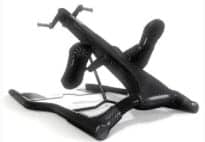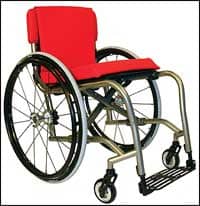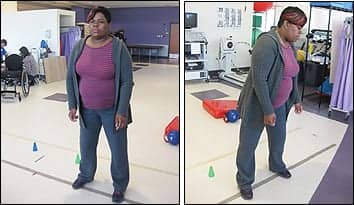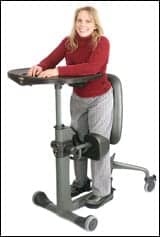 |
| Among the benefits of standing and weight-bearing programs are increased bone health, spasticity management, and bowel and bladder function. |
STANDING. It is an activity that able-bodied individuals do many times throughout the day. Why? Standing has many physiological as well as psychological purposes. It allows skeletal muscles to elongate; provides joint mobility; transfers weight off of the ischial tuberosities (sitting bones); promotes extension of the trunk, allowing for improved vital organ capacity and performance; provides proprioceptive feedback to weight-bearing joints, helping regulate resting muscle tone; enables eye-to-eye communication; increases self-confidence and overall self-image; and that is just scratching the surface.
So, what happens if someone’s disability or illness precludes them from being able to achieve a standing position? What are some of the implications of immobility for patients who remain seated for most of their day? According to a study by Deitrick et al on immobilized men without disabilities, it was shown that the following are potential complications of immobility: decreased bone mineral density, increased risk of pressure ulcers, development of joint contractures, impaired bowel and bladder functioning, impaired respiratory functioning, and increased risk of gastrointestinal problems.1
To reduce the risk of these complications, therapists and physicians often prescribe standing programs for adults and children of all ages to gain the benefits of lower-extremity weight bearing. Standing treatments can be provided through many different mediums: tilt tables, individual standing frames (static or dynamic), gait trainers or other ambulation aids, and also by integrating standing into a wheelchair seating system. There are various methods that allow a patient to achieve a standing position in these devices. Some systems utilize a sit to stand, supine to stand, or prone to stand technique only, while other systems can use multiple positions to achieve full upright standing. Some options even allow the patient to “customize” how they come to a standing position. Additionally, there are several options to operate the standing feature, including manual operation, full power operation, and combination systems—manual wheelchair with power standing (partial power operation).
Clinical evidence supports that weight-bearing programs, such as standing, are beneficial for bone health, spasticity management, prolonged stretching, pressure redistribution, bowel and bladder function, gastrointestinal motility, respiratory function, and overall psychosocial status. Additionally, the following research findings may lead a clinician to consider integrating standing into a wheelchair base as opposed to using a separate standing frame, which has traditionally been the most standard form of carrying out a weight-bearing program:
- According to the RESNA Position on the Application of Wheelchair Standing Devices, “Standing is an effective way to counterbalance many of the negative effects of constant sitting.2,3 Standers integrated into wheelchair bases enhance the beneficial effects of standing since they allow for more frequent, random and independent performance of standing than in persons who use standing devices outside of a wheelchair base. Integration of this feature into the wheelchair base also enables standing to enhance functional activities.”
- Dynamic loading of the skeletal system can be achieved when standing while the wheelchair is moving. Dynamic bone loading has been shown to be superior to static loading for reducing bone loss.4-10
- More frequent standing throughout the day has been shown to also have a greater benefit for bone density11 in addition to respiratory function,3 bowel function,3,12 bladder function,2 gastrointestinal function,2,3 and management of spasticity.2,3,13 By standing in an upright position with trunk extension, vital organ capacity improves and is less restricted. Gravity is able to assist with digestion, moving the bowels and resulting in less constipation,2,3,12 and bladder emptying, resulting in fewer instances of urinary tract infection.2 It also improves diaphragmatic support, allowing individuals to breathe with less restriction and more deeply, resulting in increased lung capacity.3 This not only directly improves oxygenation, but also allows standing individuals to speak with improved volume due to greater breath support. Regarding spasticity management, weight bearing has been shown to have an immediate and significant effect on reducing muscle spasticity.13 By being able to stand, independently, throughout the day at a moment’s notice, the user will be able to better control their spasticity as needed for function or pain control. For example, a patient can use functional standing in their wheelchair before bed when completing self-care activities such as teeth brushing and other hygiene tasks. Then, their spasticity will be reduced prior to transferring and completing lower body dressing, making them more independent and safe with these ADLs in addition to promoting a good night’s sleep.
- Individuals also use standing treatment for more effective pressure redistribution, reducing the risk of pressure ulcers. It has been documented that people who perform a regular standing program have fewer pressure ulcers.2,3,14 When a person achieves an upright position, the pressure is removed from the ischial tuberosities, sacrum, spinous processes, and scapulae—the most common bony prominences at risk for skin breakdown in a seated individual. The American Spinal Injury Association recommends that pressure redistribution activities be conducted every 15 minutes for at least 1-minute duration in order to allow appropriate blood perfusion to tissues. This can be achieved through various activities such as tilting, reclining, wheelchair push ups, leaning forward, etc, but none of these activities are as “natural” or “mainstream” as standing. Additionally, when tilt and/or recline is used, the patient’s visual field is translated upward, requiring them to look up at the ceiling instead of around their environment. Standing allows a wheelchair user to retain visual interaction and utilize a more “normal” means of pressure relief while simultaneously gaining the other listed benefits of weight bearing.
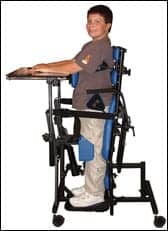 |
| Standers are available in a variety of styles, including this sliding seat stander with multiple features. |
Additionally, in studies by Trudel et al, it was concluded that prolonged stretching reduces the risk and magnitude of joint contractures.15,16 Standing is an effective way to elongate muscles, which are typically shortened in the seated posture (including iliopsoas and abdominals—trunk/hip flexors, hamstrings—knee flexors, and gastrocnemius/soleus complex—ankle plantar flexors).
There are many purposes for incorporating a standing system into a wheelchair including, but not limited to, the following:
- To gain the medical benefits of weight bearing in an upright position (standing) for individuals who are unable to do so on their own due to disability.
- To attain functional independence for performance of mobility-related activities of daily living (MRADLs), including self-care as well as occupational performance.
- To reduce the amount of assistance required by the disabled individual (often provided by paid aides or nursing staff) to transfer into a separate standing frame.
- To improve overall compliance for performing a standing program prescribed by one’s physician and/or therapist to achieve the medical benefits of standing. By having the standing feature integrated into the wheelchair system, the individual does not need to rely on someone else to complete the recommended standing regimen.
- To provide energy conservation—not requiring as many transfers throughout the day—which is essential for performance of activities of daily living. Energy conservation is also medically necessary for various diseases that are negatively impacted by excessive energy consumption and muscle activity (ie, progressive neuromuscular diseases).
- To gain the psychosocial benefits of standing and being upright. This will likely reduce secondary complications that often accompany long-term illness and disability (including depression).
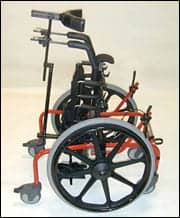 |
| The above stander can be used in a prone or supine position, and can convert into a self-propelled mobility unit. |
With an integrated standing feature on an individual’s wheelchair, the user will be able to independently achieve an upright standing position frequently as needed throughout the day, providing improved medical management and benefit. Additionally, this independence will allow the user to utilize the standing feature to assist with performance of MRADLs, and overall improved functional performance.
The benefit of having standing integrated into an individual’s wheelchair goes beyond the medical issues listed above, and also includes psychological, functional, and social benefits. The value of allowing a disabled individual to gain independence cannot be overlooked or underestimated. Allowing a person who previously was dependent to complete an activity without assistance improves that person’s confidence and encourages them to more positively contribute to society as a whole. Additionally, it will likely reduce the risk of developing psychological disorders (ie, depression) that frequently accompany disability and often require medical management (including the associated cost of these treatments).
So, what restricts a clinical team from recommending a wheelchair standing system? There are several possibilities. Some feel that it may cost too much. When comparing an external standing system along with a wheelchair to an integrated standing wheelchair system, the cost is often very similar. When factoring in all of the benefits of integrating a standing system into a wheelchair listed above, the minimal cost difference may be well worth the investment. Another concern about integrating standing into a wheelchair is that the system may not be covered by funding sources. Unfortunately, all standing systems (whether separate from or integrated into a wheelchair) often require a fight with third-party payors. There are, however, a growing number of standing devices provided (both external standers and wheelchair standers). When these items are well justified, they can be covered by funding sources. Here are some tips for getting standers approved for funding:
- List how the patient will be able to perform functional activities of daily living with less assistance—more independently! It is important to remember that the federal Medicare and Medicaid programs are separate and distinct programs of health insurance, serving different populations and having very different goals. Unlike the Medicare program, Medicaid provides eligible recipients with medical goods and services necessary for them to attain and retain independence and self-care, which is not a primary goal of the Medicare program.
- Focus on the patient’s medical issues/risk factors and how the research supports the use of a standing system to treat those specific issues.
- Research the specific policy of your patient’s funding source, and use that specific policy language in your justification and letter of medical necessity.
- Take pictures or videos of your patient using the standing device.
- Have the patient or family member write a letter about how the standing device has made a difference in the life of the beneficiary (physiologically, psychologically, emotionally, socially, functionally, etc).
- Contact the manufacturer of the recommended standing device for additional help in justifying the particular model and product recommended.
Most importantly, keep asking for appropriate equipment that is needed and deserved. As clinicians, we must not allow insurance policies and “covered” or “non-covered” lists to replace our clinical judgment and recommendations. If a standing device is required to meet your patient’s needs, you should advocate for them to receive that equipment. There are services such as state protection and advocacy programs that can help individuals through the appeal process when needed. Many of these programs can provide free legal counsel to patients and families in situations where a hearing is required. Remember, there is no alternative to standing … we do it all the time—why shouldn’t our patients be given the same opportunity?
Amy Meyer, PT, ATP, is a pediatric product specialist in Lebanon, Tenn. For additional information, contact .
References
- Deitrick J, Whedon G, Shorr E. Effects of immobilization upon various metabolic and physiologic functions of normal men. Am J Med. 1948;4:3-36.
- Dunn RB, Walter JS, Lucero Y, et al. Follow-up assessment of standing mobility device users. Assist Technol. 1998;10:84-93.
- Eng JJ, Levins SM, Townson AF, Mah-Jones D, Bremner J, Huston G. Use of prolonged standing for individuals with spinal cord injuries. Phys Ther. 2001;81:1392-9.
- Fritton SP, McLeod KJ, Rubin CT. Quantifying the strain history of bone: spatial uniformity and self-similarity of low-magnitude strains. J Biomech. 2000;33:317-25.
- Lanyon LE, Rubin CT, Baust G. Modulation of bone loss during calcium insufficiency by controlled dynamic loading. Calcif Tissue Int. 1986;38:209-16.
- Lanyon LE, Rubin CT, Static vs dynamic loads as an influence on bone remodeling. J Biomech. 1984;17:897-905.
- McLeod KJ, Rubin CT, Otter MW, Qin YX. Skeletal cell stresses and bone adaptation. Am J Med Sci. 1998;316:176-83.
- Rubin CT, Lanyon LE. Regulation of bone formation by applied dynamic loads. J Bone Joint Surg Am. 1984;66:397-402.
- Thompson CR, Figoni SF, Devocelle HA, Fifer-Moeller TM, Lockhart TL, Lockhart TA. From the field: effect of dynamic weight bearing on lower extremity bone mineral density in children with neuromuscular impairment. Clinical Kinesiology. 2000;54(1):13-8.
- Ward K, Alsop C, Caulton J, Rubin C, Adams J, Mughal Z. Low magnitude mechanical loading is osteogenic in children with disabling conditions. J Bone Miner Res. 2004;19:360-9.
- Frost HM. Skeletal structural adaptations to mechanical usage (SATMU): 1. Redefining Wolff’s law: the bone modeling problem. Anat Rec. 1990;226:403-13.
- Hoenig H, Murphy T, Galbraith J, Zolkewitz M. Case study to evaluate a standing table for managing constipation. SCI Nurs. 2001;18(2):74-7.
- Bohannon RW. Tilt table standing for reducing spasticity after spinal cord injury. Arch Phys Med Rehabil. 1993;74:1121-2.
- Hobson DA. Comparative effects of posture on pressure and shear at the body-seat interface. J Rehabil Res Dev. 1992;29(4):21-31.
- Trudel G, Uhthoff HK, Brown M. Extent and direction of joint motion limitation after prolonged immobility: an experimental study in the rat. Arch Phys Med Rehabil. 1999;80:1542-7.
- Trudel G, Uhthoff HK. Contractures secondary to immobility: is the restriction articular or muscular? An experimental longitudinal study in the rat knee. Arch Phys Med Rehabil. 2000;81:6-13.



